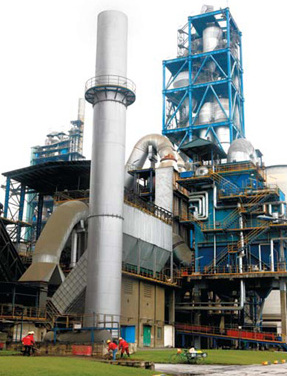Sino-Norwegian cooperation on Management of Wastes in Cement Kilns
New treatment set to prove waste reclamation Holy Grail
(China Daily)
Updated: 2009-12-24 07:49
 |
Large Medium Small |
|
Cement plants play an important role of the co-processing of hazardous wastes in cement kilns for the ongoing sustainable development of the cement industry and the abolition of potential pollutants. Yang Shizhong |
Editor's Note: Kre Helge Karstensen is the chief scientist & special advisor of Foundation for Scientific & Industrial Research (SINTEF) of Norway. Here he outlines his belief that co-processing may prove the answer to China's growing waste pollution problem.
Many now believe that cement kilns have proven to be an effective means of recovering value from waste materials. Co-processing in these kilns is now a viable option for treating industrial and hazardous wastes in many developed countries. Co-processing has been the sole solution for organic hazardous waste treatment in Norway for more than 25 years. The process recovers a significant amount of the waste in Europe and treats 25 percent of the hazardous waste produced in the US.
China currently has thousands of cement plants in operation, producing 1.4 billion tonnes of cement - 50 percent of the world's total production. The Chinese cement industry consumes over 2 billion tonnes of virgin raw materials, more than 150 million tonnes of coal and about 150,000 million kWh of electricity annually. It is responsible for emitting carbon dioxide, large amounts of dust, NOx and SO2.
A win-win concept?
Co-processing means the recovery of the valuable energy and materials in the wastes by using existing facilities. This reduces the need to invest in new, expensive and purpose-built incinerators. The immediate incentive for the cement industry is cost savings. For instance, they need less coal and fewer raw materials.
The advantages for society overall is increased capacity for waste and hazardous waste treatment, improved sustainable energy and resource efficiency as well as a significant reduction of green house gas emissions, due to the reduced consumption of fossil fuels and limestone.

A similar substitution of fossil fuel and raw material in the Chinese cement industry, as in Europe could mean a reduction of the CO2 emissions in the order of 100 million tonnes per year or more, when compared with incinerating or landfilling the wastes. When the cement industry begins to substitute fossil fuel and raw materials with waste materials, they are subsequently regulated as waste management activities. These receive more scrutiny than conventional cement production, implying investment in improved performance, and as a consequence, reduced overall emissions.
What remains to be done?
This project has conducted studies under Chinese baseline conditions for implementing a sound co-processing practice, compiled lessons learned on the best examples of international practice, built capacity among stakeholders, developed guidelines/standards and conducted several pilot demonstrations around China, leading to the destruction of hundreds of thousands kilo of hazardous chemicals.
Co-processing has just begun in China and responsible implementation will take time. To ensure safe and sound practices in the future, it needs to develop a proper regulatory system, with adequate guidelines, standards and permitting systems, and to build broad capacity on all aspects of co-processing, covering central and local authorities, academia and consultants, cement and waste industry, as well as media and NGOs.
(China Daily 12/24/2009 page12)








